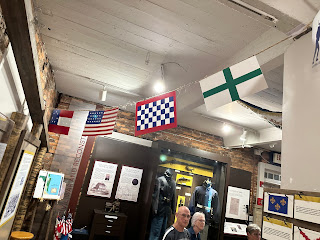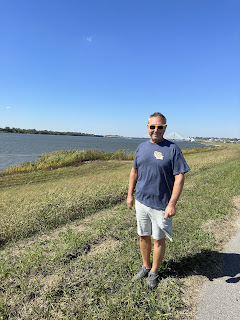Amelia Island, The Island of 8 Flags and Fernandina Beach (MM 716.7)...
March 28, 2023
Amelia Island is truly an island which has been under the rule of 8 different flags. The Indians occupying this land known as the Timcuans were a group of 9 different tribes who shared the Timcuan language. They had no flag. In 1562-1565, the French Huguenots were the first settlers. After they were killed by the Spanish explorers, Spain took over and flew their flag 1565-1763. The town of Fernandina was named after the Spanish King at that time. The third flag was that of Britain and the name of Amelia was related to the daughter of King George II of Britain when Georgia settlers destroyed the settlement 1763-1783. Spain from 1783-1821 regained control of the area from Britain and flew their flag. There were 3 interruptions in Spain's rule of the island. During the War of 1812, the US secretly supported an overthrow of the Spanish government. The Patriot flag was flown but Spain demanded the island back and it was granted. The fifth flag in 1817, was a very short term of the "family flag" of Gregor MacGregor which was white flag and green cross. Luis Aury, a pirate, raised a Mexican rebel flag in December 1817 and he held the island "in trust" while Spain and the US discussed the future of Florida. The US flag would fly over the island in 1821 as the US would purchase Florida. The 8th flag would be that of the Confederates which would hold the island 1861-2.
We enjoyed a very smooth ride today on the St John's River. Some loopers go further "up" the St John's River to explore the wildlife which goes to Sandford, Florida. Yes even though you are traveling south, the river flows north. While we debated back and forth but due to other commitments, decided to continue north. We will do this in the future by car. Dolphins, ospreys, a kingfisher, and woodstorks were seen during our travel along the waterway.
Luckily, we did not have to get in the busy traffic of the Jacksonville port. We brought the kids to Amelia Island many years ago when I had a conference in Amelia Island and enjoyed it.
Despite multiple changes in governments, Fernandina Beach was a very active port. Many ships which were made of wood frequently would have shipworms that ate holes into the wood. One of the interesting things about these ships is when they came into the inlet of Amelia River and St Mary's River, the captains were assured that there would be 17 feet of water and the marsh grass when it died would release tannins into the water which would kill the shipworms. So in addition to loading and unloading materials, many ships would stay in the area to "soak" their boats in this water to rid the ship of shipworms. During the US Embargo Act of 1807, no business was allowed to be done with other countries. So many ships came into this area as business could be done here by crossing over from Georgia due to its control by Spain. David Yulee the 1st senator from Florida, worked to provide a railroad across the northern aspect of Florida from Fernandina to Cedar Key in the 1850's. The railroad took 8 years to build. With the outbreak of the Civil War, the railroad was destroyed as the Confederates needed the metal for the war. In the 1880's, Henry Flagler came to the island to discuss running a spur of his railroad to the town. Business was good and the local hotels were not interested and said no to Flagler. Once the railroad was put in place, the town saw tourism decrease and the area suffered in their economy. Many of the beautiful buildings and homes from the 1880- early 1900's appear to be well maintained. The post office is the original building. The school building is now a B&B and the Principal's office is The Bar. While in the Amelia Island Museum, the docent told us that Union Carbide owned a large portion of land on the southern part of the island. Their plan was to strip the land for tungsten which never happened and the land was purchased by the group that developed the Amelia Plantation with many homes and condos. I asked why Union Carbide didn't move forward and he did not know. We saw beautiful structures including the Post Office and the School building.
At the most northern end of the island is Fort Clinch. This is a park currently and we rode our bikes out to see it. The fort was built in 1847 to add protection to the island and entry into Georgia and Florida. The masonry fort is considered a Third System Fortification although it was never fully completed. It was actively used during the Civil War, Spanish-American War, and World War II. During the Civil War, the Confederates held the fort for 1 year and came to the conclusion they could not continue this position and General Lee, withdrew troops to move them to more important areas. Like the other places on the east coast of Florida, this fort during World War II was used to monitor ship traffic even though during this time, it was actually a state park. In 1935, the Civilian Conservation Corps (CCC) restored the area and built roads to access as a state park. You can see the beach of Cumberland Island, Georgia in the distance.
While we were at the northwestern part of the island, we traveled by Uber down to American Beach. The land was purchased in 1935 and developed by Abraham Lincoln Lewis, who was President of Afro American Life Insurance. He purchased 33 acres and then another 183 acres. This allowed black families to purchase land and enjoy the beaches at Amelia Island. Many alumni from Tuskegee Institute purchased land and built summer homes at this area. Lewis advertised the area as "Recreation and Relaxation without Humiliation." There were small hotels here and they were listed in "The Green Book."
Directly across the street from American Beach is the highest sand dune in Florida (60 feet), named NaNa.
Danny and I enjoyed drinks at the Palace saloon. The best drink was the Pirates Punch. This bar is the oldest bar in Florida in business since 1903. Adolophus Busch helped the owner start his business by providing the wooden backdrop for the bar from the World's Fair. During prohibition, the bar was kept open selling non alcoholic drinks (and I'm sure there was alcohol sold too). Danny also found breweries but no great beers. We did find great places to eat. Espana (Spanish tapas where I ate with a friend, Kathleen 10 yrs ago) and Le Clos- excellent!
Another important item is modern shrimping was founded here. The development of the Turtle Extrusion Device(TED) was done here. The business was Burgess Trawling which is now Burgess Sport nets. I sent the president an email asking if I could come by his factory but never heard from him, unfortunately. The shrimp nets they made allowed for turtles and dolphins not to be collected within the nets with great success. Currently, according the docent at the Museum, the business provides the NFL all the nets that go up with every extra point and field goal kicked as well as the nets in the NHL to prevent pucks from injuring people.
While at the Marina we had a large ship with the Army Corp and another ship from Cape Fear Community College. The college ship had students working towards their associate degree in marina management. The students I spoke with were finishing in May.
You can see Amelia Island Lighthouse from a distance. This lighthouse was reassembled in 1838 as it was moved from the southern end of Cumberland Island brick by brick to Amelia Island. The incredible sunset we saw and then leaving in the morning, a beautiful sunrise. Down at the water is an active train that moves materials to the paper plant.



























Comments
Post a Comment